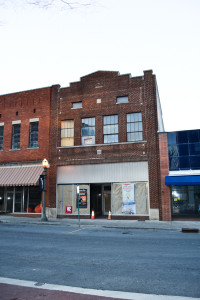
This building was totally renovated in 2015 for expanded technical office space. Images taken by R&R in 2015.
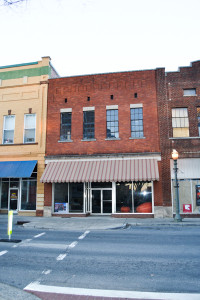
The Friends of the YC Library have recently announced this building will be used as their new bookstore on Main Street.
The Yorkville Enquirer reported on the sale of Fishing Creek Mills (Lando Mills), to F.H. Barber on Sept. 18, 1879.
The RH Herald reported on May 19, 1881 – “Mr. F.H. Barber is making extensive repairs to his residence on Main Street. He proposes to add to its size and beauty.”
The Yorkville Enquirer reported on June 12, 1889 – “On Sunday night a thief entered the residence of Dr. W.E. Black on the corner of Main and Hampton Streets. The house has two entrances, one on Main and the other on Hampton. The family was on the porch facing Main Street at the time of the robbery in the rear of the house.”
Later on Oct. 27, 1881 the Herald also reported – “Mr. T.C. Ward has a good reputation as a builder. He remodeled Mr. F.H. Barber’s house in a beautiful manner. He also recently did remodeling work at Harmony Church. He has the contract for the woodwork on the new buildings on Main Street being erected by Capt. A.E. Hutchison.”
City Directories and History: 1908 – (#162) F.H. Barber and J.B. Sykes, (#206) T.W. Joyner and City Pressing Club
Mrs. Rosa B. Guess who grew up on Hampton and Johnston Streets considered Mr. F. Barber – “The master of baking the perfect fruit cakes.” (Read extensive history this page.)
“Let us now go back to the corner of Main and Hampton Street. On the southeastern corner stood the large rambling house of Mr. and Mrs. Ferguson H. Barber. This house had an elaborate porch wrapping around the side that faced East Main Street. Mr. Barber owned the Manetta Mills at Lando, S.C. Each morning he left Rock Hill early and drove a horse to Lando and came back that afternoon.

Older image of Rock Hill’s Main Street in the 1940s, image taken from the top of the Baptist Church. Courtesy of AFLLC – 2012
Next to the Barber house was Kimball’s livery stables, owned and run by Mr. S. J. (“Mr. Stoney”) Kimball and his two sons, Will and David. Somewhere in that same area was the little photography studio of M. Carlisle, one of Rock Hill’s first professional photographers. (The “M” in his name stood for “Marion.”) His wife died early, soon after they came to Rock Hill, and he was left to rear three children: a son, Marion; and two daughters: Ora Lee, who never married and who worked at the City Hall for many years; and Ava, a nurse, who married the realtor Ira W. Snipes. Next to the livery stable was Mr. Kimball’s residence, a frame house surrounded by trees and pretty flowers.” (The old Rock Hill National Bank – BOA built its headquarters building on the site of the Kimball house.) [Robbins – White Tour History]
The Herald reported on Jan. 8, 1885 – “Mr. F.H. Barber informs us that with fifteen mules on his various farms last year he made 140 bales of cotton.”
The Herald reported on Oct. 13, 1887 – “Mr. Mattie Wilfong of Hickory, N.C. has rented the home of Mr. F.H. Barber, recently occupied by the Rev. W.B. Jennings, and will open a boarding house there the first of next month. Rev. Jennings has resigned the pastorate of the Presbyterian Church to take another pastorate.”
F. H. BARBER CONTRACT WITH FREEDMEN
The Rock Hill Herald on March 7, 1942 ran an article describing an old contract in the possession of J. A. Barber of Rock Hill. It was a contract between his father, F. H. Barber, and the freedmen, former slaves on his plantation. The date of the contract is not given, but the period covered is the year 1867. It describes the labor for 11 former slaves and is signed by F. H. Barber and J. Lumpkin (probably an overseer), with “X” marks for all the slaves. In the contract, Barber agrees to hire the freedmen for work on his plantation, “Said employers agree to treat the said freedmen with justice and kindness…” The names of the freedmen and the payments to be made to them for one year’s work were: Reuben Barber ($125), Bill Barber ($100), Isick Barber ($80), Smith Barber ($80), Jeff Kee ($80), Sam Kee ($80), Tom Roach ($75), Anderson Barber ($75), Charles Barber ($60), Bill Kee ($50), and Jeff Barber ($40). The contract calls for Barber to feed the men. They agreed to forfeit 50 cents for every day of labor lost to sickness or unexcused absence. They can be dismissed with loss of wages if they refuse to work or leave the farm without permission.The Yorkville Enquirer on Nov. 28, 1894 reported – “Mr. F.H. Barber of the Fishing Creek Manufacturing Co., has leased the factory to Mr. McGowan of Enoree.”
The Herald reported on Aug., 28, 1897 – “That the handsome residence of Capt. F. H. Barber on Main Street is in the hands of the painters this week.”
The Rock Hill Record reported on Feb. 25, 1907 – “That there was a fire in a small tenant house in the backyard of Mr. J.H. Barber. The tenant house was only twenty feet from S.J. Kimball and Sons Livery Stable. The fire dept. acted quickly and prevented the spread of the fire but the house was completely destroyed.”
Lots 7 and 8 South—Thanks to an item in Rock Hill’s first newspaper, the Indian Land Chronicle, issued January 21, 1859, we know that Joseph N. Steele purchased these lots at the southeast corner of Main

1884 Sanborn Map diagram of the Ferguson Barber house which once stood on this lot.
and Hampton streets on Saturday, January 15, 1859. It is likely that Steele became associated in business about this time with William B. Fewell. Nothing further is known of the earliest history of these lots, except that Fewell deeded his half interest in the property to Joseph N. Steele in 1868 for $1,200. Then, later in the same year, J. S. R. Thomson and T. S. Jefferys, assignees of Joseph N. Steele, deeded the lots to Ferguson H. Barber, Rock Hill merchant and mill owner. Two interesting facts may be gleaned from the latter deed: (1) there was a house of some kind on the property and (2) the consideration was only $300, indicating that something in addition to money was given for the lot.
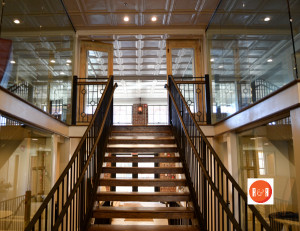
Images capturing the modern re-use designs applied in the update of the building in the fall of 2015.
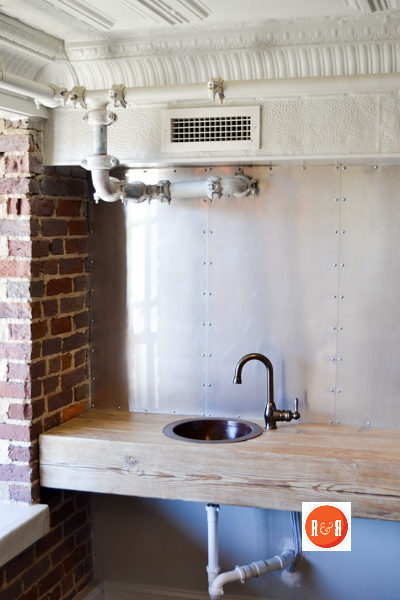

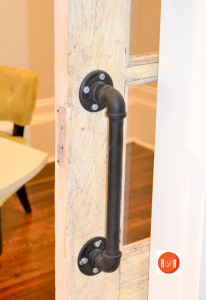
As related in the accounts on Lots 5 and 6 North, Ferguson H. Barber sold his residence on the north side of Main Street to John R. Allen and moved across the street and built a large, fine residence on the two lots under discussion. This took place in the late 1870’s or very early 1880’s. The Barber house, with its spacious wrap-around porch and gingerbread trim, stood until some time after 1910. Downtown residences had been gradually disappearing since the turn of the century, as vehicular traffic and business houses steadily increased in size and number. The Barber house was one of the last to go, along with Captain W. L. Roddey’s mansion up the street.
F. H. Barber probably owned all the land south of his two Main Street lots, to Black (formerly Church) Street. On February 22, 1889, he sold a lot on the northeast corner of Black and Hampton to Mrs. Fannie (Ratterree) Roach, widow of William L. Roach. 53 Mrs. Roach had formerly lived at the northeast corner of White and Depot streets. She sold off her large house and lot there to Rock Hill’s second railroad company, the Charleston, Cincinnati and Chicago, for use as the depot and freight station lot. Mrs. Roach’s Hampton Street lot measured 127.38’ x 132’.
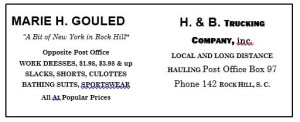
Advertisement from the 1938 Rock Hill Bearcat annual.
The People’s Trust Company, about 1919, acquired Lots 7 and 8 and divided the parcel into four 30’ lots. The lot immediately bordering the streets was used for

Advertisement from the 1938 Rock Hill Bearcat Annual.
an auto service company, which featured a filling station (gasoline and oil for automobiles and trucks). In 1944 S. Jack Kimball and his wife, Adelaide (Miller) Kimball, purchased this lot for use by Kimball Flower Shop. The last occupant that the writer remembers was Bea’s, in the 1980’s.
The next 30’ lot to the east was used in the 1930’s to house a dress shop called “Marie H. Gouléd, A Little Bit of New York in Rock Hill.” A more recent business there was Marion Davis. To the east of this lot was that occupied in the 1930’s by Jacobs Furniture Company, followed by Moore Furniture Company. The last of the four lots carved from the Barber property was occupied by Elder’s Grocery Store and more recently by an establishment known as Scottie.

Ferguson Barber’s 19th century home which once encompassed these much of lot #7 (Corner of Hampton and East Main). Image courtesy of the WU Pettus Archives – 2015 The Herald reported on Aug., 28, 1897 – “That the handsome residence of Capt. F. H. Barber on Main Street is in the hands of the painters this week.” Louise Pettus wrote, “There was a dispensary shop in Tirzah but none in Rock Hill and that was largely because of Barber’s opposition. Roddey said he vividly remembered the day Rock Hill voted on the issue. Venerable old Mr. Ferguson H. Barber was early at the voting place, took his seat in a chair and just sat there all day from the time the polls opened until the close… he never made any appeal to any of the voters, he just sat there and stroked that long white beard and when the voting was over Rock Hill had turned thumbs down on whiskey. “
The total front footage of Lots 7 and 8 would have been 136’. It is probably that the extra 16’ available after subtracting 120’ for the four lots aforesaid was used to provide a sidewalk on Hampton Street and perhaps to widen the street itself, which from the beginning was considered to be only an alley to connect Main Street with Church Street to the south.
[Information provided via Along the Land’s Ford Road – Vol. I, 2008 by William B. White, Jr.]
The Rock Hill Record reported on Oct. 8, 1908 – “The homestead of Mrs. Ferguson H. Barber is being remodeled throughout.”
The Rock Hill Herald reported on Dec. 5, 1919 contained an ad announcing the sale of Barber’s Corner with four lots, each 30 ft wide and 107 ft deep. The sale by held by People’s Trust Company.
The Herald reported on the auction on Dec. 11, 1919 – “Lot #1 including the Barber House is the corner lot and was bought by B.J. White. Price for all four lots was $53,903. (The Barber House was sold to R.T. Fewell for $525.00 and the wood house to J.E. Williams for $26.00)
- Lot #2 was purchased by Rock Hill Supply Company
- Lot #3 was purchased by Calhoun Drug Company
- Lot #4 was purchased by Diehl – Moore Company (This lot included a half interest in the wall on the eastern side.)

Image of the corner of Hampton Street and East Main – Filling Station – Ca. 1952 (Courtesy of the Couick Collection)
“My father, Mr. Paul T. Williams, worked for the 5 & 10 Cent Store as assistant manager in 1936; from 1937-1940, he worked at Moore’s Furniture Store; then he became a policeman, 1940-1942.” Judy Nation – 2015
The Diary of Kate J. Hutchison states “the Elder’s are careless over the maintenance of the store…”
The Rock Hill Herald of March 22, 1920 stated, “it is sad to see the old home of Ferguson Barber demolished – he was the best farmer in York County.”
The Herald on May 18, 1910 reported, “Headen Bynum of Pittsboro, N.C., will move his family here in September. They will occupy the F.H. Barber residence on the corner of Main and Hampton Street. He will join the firm of the Bynum Poe Mercantile Company.”
Stay Connected
Explore history, houses, and stories across S.C. Your membership provides you with updates on regional topics, information on historic research, preservation, and monthly feature articles. But remember R&R wants to hear from you and assist in preserving your own family genealogy and memorabilia.
Visit the Southern Queries – Forum to receive assistance in answering questions, discuss genealogy, and enjoy exploring preservation topics with other members. Also listed are several history and genealogical researchers for hire.
User comments welcome — post at the bottom of this page.
Please enjoy this structure and all those listed in Roots and Recall. But remember each is private property. So view them from a distance or from a public area such as the sidewalk or public road.
Do you have information to share and preserve? Family, school, church, or other older photos and stories are welcome. Send them digitally through the “Share Your Story” link, so they too might be posted on Roots and Recall.
User comments always welcome - please post at the bottom of this page.


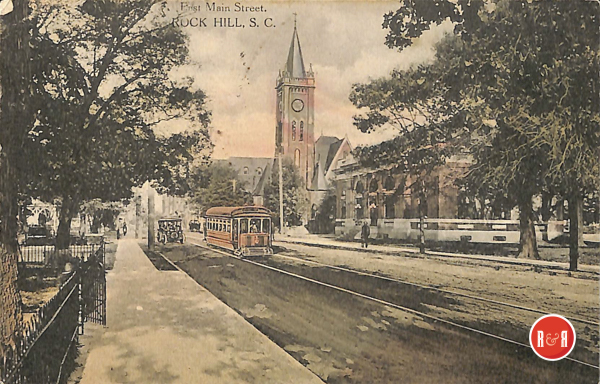

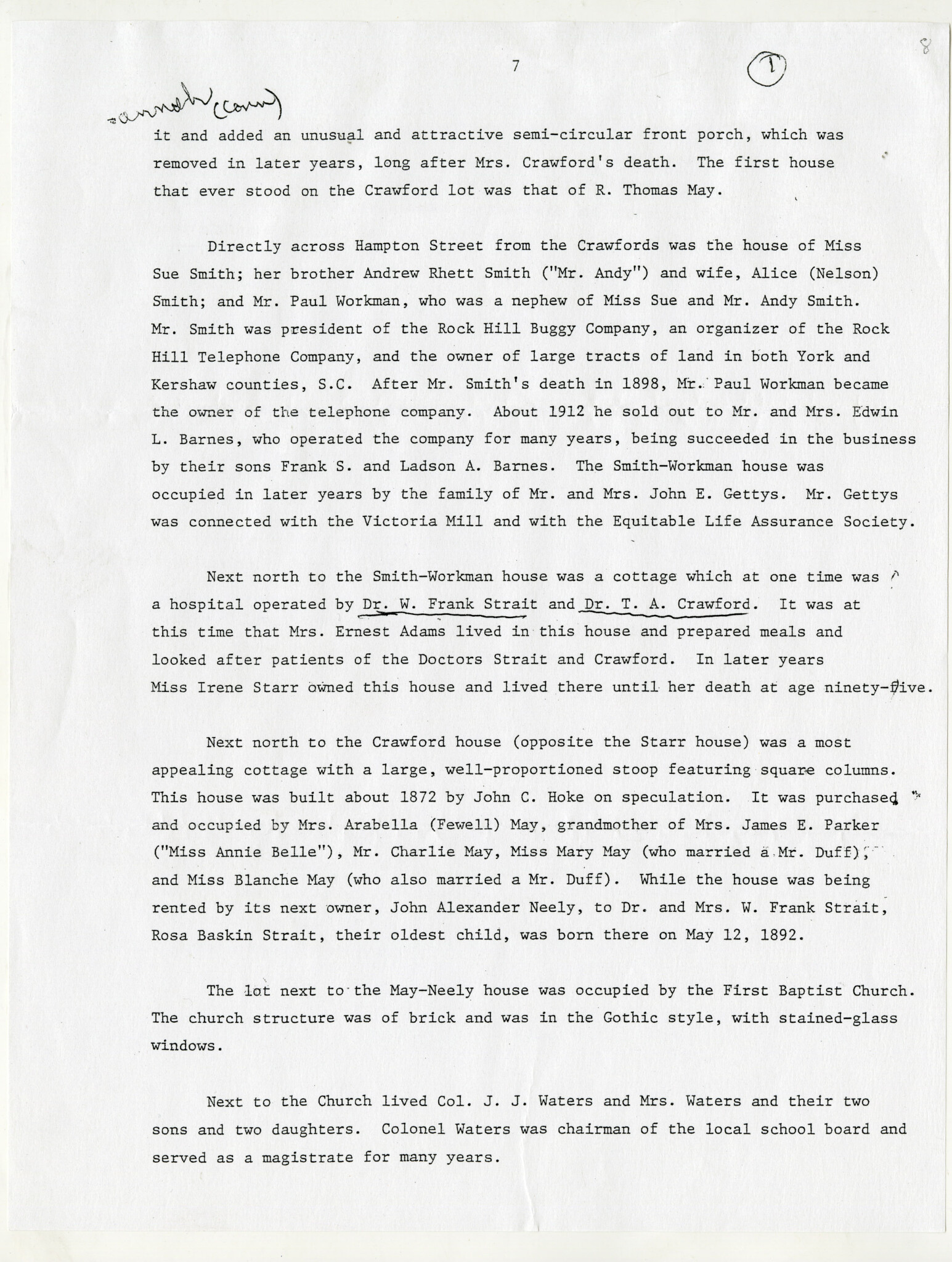 Click on image to pan and zoom.
Click on image to pan and zoom.
 Click on image to pan and zoom.
Click on image to pan and zoom.
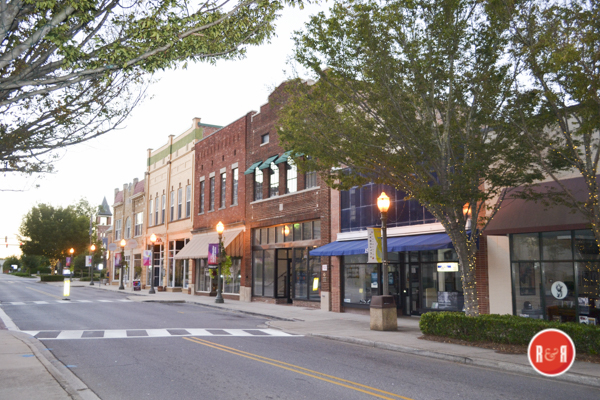



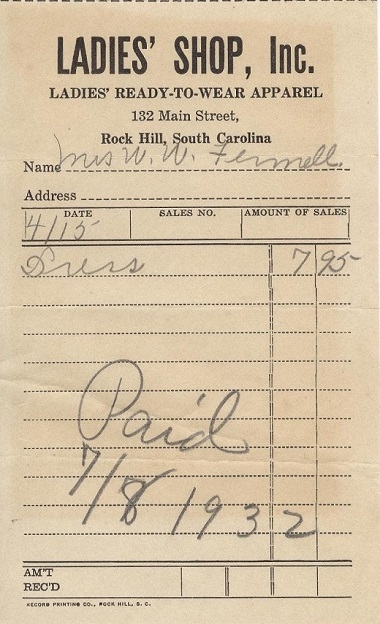


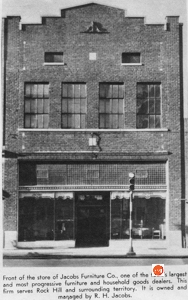
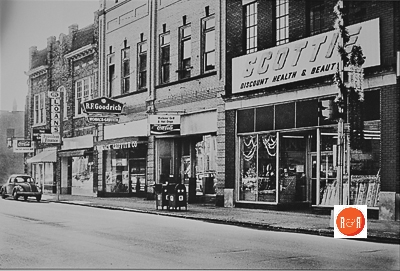






Share Your Comments & Feedback: